This is the second column in a four-part series by Nicholas Whittaker on black horror. Read the first here.
H.P. Lovecraft dreamt of unholy architectures. His stories abound with accounts of attic rooms with “peculiar angles”; “dimly sinister” cathedrals; “ancient tottering” cottages exuding “faint miasmal odour”; “malodorous and fear-shadowed” towns rotted with “irredeemable pollution.” These places are haunted. Too real, too present, they nonetheless somehow embody what lies “outside the boundaries of the world of space we know.” Their brute material form, their look and texture, is suffused with a fundamental wrongness. Such uncanniness is only heightened in Lovecraft’s visions of genuinely foreign and unnatural edifices: the crumbling ruins of cities that once housed monstrous, inhuman beings; monoliths paying homage to secret and unbelievable gods; metropolises in strange, forgotten lands outside our present dimensions; passageways that are simply too big buried under desert sands: the playgrounds and torture chambers of species and divinities now gone from the earth, or hiding dormant in its core, or returned to their alien worlds.
These hallucinatory imaginations reach a loving climax in At the Mountains of Madness, published months before Lovecraft’s death. The novella’s plot largely consists of Antarctic explorers stumbling across, then painstakingly exploring, a massive, empty city that once housed a grotesque prehistoric race. Lovecraft strains to convey the horror of its physical form:
I shuddered as the seething labyrinth of fabulous walls and towers and minarets loomed out of the troubled ice-vapours above our heads. The effect was that of a Cyclopean city of no architecture known to man or to human imagination, with vast aggregations of night-black masonry embodying monstrous perversions of geometrical laws and attaining the most grotesque extremes of sinister bizarrerie. …
I think that both of us simultaneously cried out in mixed awe, wonder, terror, and disbelief in our own senses as we finally cleared the pass and saw what lay beyond.
It is no small feat that a moment in Atlantics, Mati Diop’s 2019 debut feature film, evokes that precise admixture of emotion. Many have attempted to adapt Lovecraftian horror to the screen, but most have failed. The grandiosity, the whiff of insanity, above all the translation of metaphysical blasphemy into “stark, objective, and ineluctable reality” escape their efforts. But not this one.
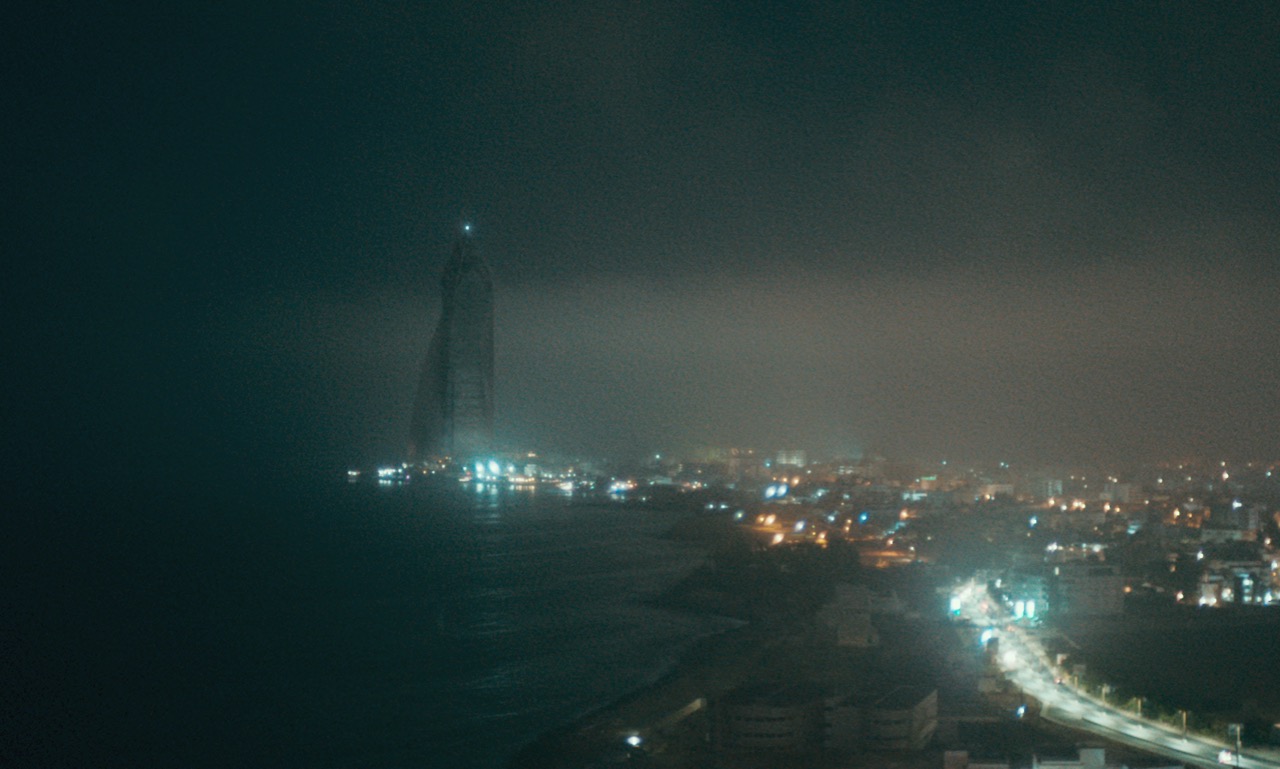
This shot emerges nearly exactly in the middle of the film, and I cannot quite capture the disquieting sense of animism, the aura of breathing, unnatural life that wreathes this dark tower. It thrusts high above the landscape of Atlantics, looking for all the world like the “blasphemous fortress” that looms over the ancient kingdom of K’naa in Lovecraft’s story “Out of the Aeons,” a “distant and geometrically abnormal outline against the sky.” At its crown sits a perverse star.
But does this temple merit such florid description? After all, it is not in K’naa, or the cobwebbed streets of Lovecraft’s Arkham, or the great mound of K’n-yan, or the faraway lands of Kadath or Lomar. It was not erected by the cult of Cthulhu, or the worshippers of Shuggoth, or the mad prophet Abdul Alhazred. Nothing so grandiose—it lies in the city of Dakar, on the westernmost point of the Old World, overlooking the Atlantic Ocean, in Senegal. And it is a luxury high-rise, overseen by a man named Mr. Ndiaye, built by the hands of Senegalese men. It is nothing more sinister than that.
The dreadful power and arrhythmic beauty of Atlantics lie in the fact that this is enough. In the shimmer of the tower’s black glass, Diop’s camera sees the radiation of an irredeemable pollution. That atmospheric smog does not choke the streets of Dakar so much as constitute them. The world of Atlantics is made of a material that unspools in disorienting bends and waves impossible to calculate. We might, if we were feeling clever, call that material “colonialism,” “anti-blackness,” “capitalism,” “patriarchy” or any number of other well-meaning, correct, but ultimately insufficient phrases. The architectural textures—the physical, tangible space—of Atlantics exceed these political categories and moral condemnations; this is what makes the film horrifying.
Here lies the first thesis of black horror: the black world is a Lovecraftian world. It is not a world that simply contains some sort of atrocity. The evil of anti-blackness is so unnatural, so monstrous, that it seems to come from outside the boundaries of the world of space we know; it goes against the sense of everyday life. And yet that outside is, impossibly and horrifically, here, all around us: engraved in the atoms and the kinetic energy of stark, objective and ineluctable reality. What Atlantics shows so brilliantly is that the presence of that outside transforms reality, rendering it precarious—and haunting.
●
The plot of Atlantics is simple. A girl, Ada, is in love with a boy, Souleiman, but is engaged to another, Omar. Omar is rich; Souleiman is a construction worker, building Mr. Ndiaye’s Tower of Babel. But Mr. Ndiaye fails to pay his workers for months, and so a cadre of them—including Souleiman—attempt to sail from Dakar to Spain. The boat sinks, and the boys drown.
And yet, they return. Each night, a group of girls—friends and lovers of the boys—are possessed by the dead. They haunt Mr. Ndiaye, threatening him with escalating retribution until he pays their loved ones the long-overdue wages. Not Ada, though: Souleiman does not enter her, but rather the policeman questioning her for her involvement in these acts of aggression. That is because, as she eventually learns, he only wishes one thing: to see her again, to give her the goodbye he was too afraid to offer before. They share one night together, Ada and the policeman and Souleiman. The boy leaves.
Dakar is the westernmost point of the continuous landmass now conceptually split into Africa, Europe and Asia. Just south of its tip is the small island of Gorée. Gorée was one of the first territories in what is now known as Senegal to be colonized by France, who would later claim the vast majority not only of Senegal but of northwestern Africa. This eastward expansion would not begin in earnest until the mid-nineteenth century. Until then, Gorée served purpose: West Africans would bring peanuts, gum arabic, ivory and, most of all, slaves to Dakar, and then Gorée, to sell to European traders. This island—the Door of No Return, now a macabre tourist destination—helped pump the blood of the Atlantic slave trade. In a grim irony, the abolition of slavery in the French colonies in 1848 opened the door to formal colonization in West Africa. Senegalese slave owners and traders were stripped of their main source of income and labor force—a blow to the indigenous economy that provided a foothold for the French to expand into the mainland. Of course, this did not change much in one important sense. As before, the economic security of Senegal remained across the Atlantic, in the French companies distributing Senegalese peanuts, the country’s main cash crop. Across these centuries, Senegal was haunted by lands far beyond it, perforated with circulatory systems latched to shadowy masses imperceptible by the human eye. This is colonization: possession.
Even after independence was declared in 1960, there was no final severance from the biomass named France. The Senegalese economy remained heavily entangled with the metropole. Now, however, the burgeoning Senegalese bourgeois would receive a larger slice of the pie. This use of colonial continuity for elite gain would only grow with Senegalese liberalization at the turn of the twentieth century. As of 2021, Senegal is ranked 170th in the Human Development Index, even though the nation has a relatively strong GDP among African countries and an unemployment rate of under 4 percent. The disjunction is the result of vast stratification: while the elites of Senegal are made discomfortingly wealthy by foreign investment and trade, nearly half the country lives below the poverty line.
Atlantics is an attempt to make a movie that distills, in Diop’s words, the “very ghostly atmosphere reign[ing] in Dakar.” The film is clearly about colonialism and anti-blackness and slavery. Mr. Ndiaye transforms his Senegalese workers into literal slaves by refusing to pay them; their flight to Spain, a flight that could only end in either death or underpaid migrant labor, is the ferrying of slaves from one corner of the empire to another. The brutality of this cycling of human equipment haunts Dakar, hanging over its inhabitants even when it occurs far out at sea. And over them all hovers the tower: a grotesque obelisk, a summoning rod, a psychic tuning fork, exchanging human lives for foreign investments in a ghostly economy.
Imagine colonial extraction as a chthonic ritual, overseen by indigenous high priests. These mediums, alternating schizophrenically between French and Wolof, midwife a psychic infestation of the material world by a formless, nameless thing: no mere country, no mere emperor, but an overwhelming beast of structures, relations, dynamics, ways of being and thinking and doing, an entire shadowy world called empire. Such a way of talking fleshes out the metaphorical sense—if indeed that sense is merely metaphorical—in which France, colonialism, slavery haunt Senegal. To be haunted is to be privy to, to be formed by, to be terribly indebted to something utterly beyond you, something outside the boundaries of the space you know. This outside has formed Senegal, and dismembered it, facilitated by its wealthiest inhabitants.
The film’s possession narrative, then, simply makes this metaphorical way of talking literal: Dakar is literally haunted by its dead. A second thesis of black horror: the films show us what it would look like if metaphorical descriptions of the reality of anti-blackness were made literal. In this film, that reality is European colonialism, the slave trade and economic disenfranchisement. But in others, we are shown the reality of migrancy (His House), American chattel slavery (Beloved, Antebellum), black fetishism (Get Out), cultural displacement (Ganja and Hess) and so on. These realities are united, of course, by the trauma, the black suffering, that lies at their core. One might say that living in migrant housing feels like living in a haunted house; as IndieWire puts it, His House “sees the immigrant experience as a horror movie.” One might say that black fetishization feels like the desire to be consumed; as the New York Times describes Get Out, “one person’s fiction, after all, is another’s true-life horror story.” One might say slavery felt like being transported into hell; as the Washington Post describes Beloved, the film’s ghost is a “metaphor for the vestiges of a horrific past.” Or one might say that living in Senegal feels like being haunted by a monstrous parasite that absorbs money and lives and land, and by the ghosts of those consumed by it.
But why bother with these particular metaphors? What do they offer us, such that we now dedicate an entire genre to them? Why horror?
●
In order to answer that question, let us first ask how: How does Atlantics literalize horrific metaphor? How does it depict haunting? That question goes oddly unexplored in discussions of the “reality” that black horror films show to us. Perhaps that is because posing it reveals a problem. How could one capture, with a film camera, being haunted, if being haunted is the experience of what is not present? Film cameras, after all, show us something. They make something present—a river rushing, a twisted tree, that look in someone’s eye. Whatever it is, we get to see it: movies reveal the world to us.
Clever movies make clever use of this. A film may reveal a schizophrenic’s delusions as though they were “really happening.” Another might, in telling the story of two lovers separated by an ocean, transpose the two over each other through fuzzy dissolves or jarring split screens. A third might use smoke and mirrors and CGI to trick us into seeing something that isn’t there. In these ways, films allow our experience of the world to grow, to swell beyond the confines of our typical experience. Inner worlds play out in sound and color; dreams become real; the border between reality and fantasy crumbles.
But within this power lies the problem. For the metaphor of haunting seeks to capture some sense in which something is both present and not present, seen and not seen. Trying to imagine the experience of something “outside the boundaries of the world of space we know,” we run into a crisis that has haunted philosophy since at least Hume, and perhaps a great deal longer: How can we know what we do not know? How can we experience that which lies beyond experience? How can we circumnavigate the limits of thought? The horror Lovecraft describes is the terror that accompanies the contemplation of this crisis. To contemplate the possibility of a world beyond the limits of one’s contemplation, to grapple with one’s own fundamental finitude in a reality that is so inhuman as to be indescribable in our terms and yet is parasitic, birthing us and threatening us again and again: such wonders are inherently destabilizing. They haunt us.
Very well: But how do we make movies about this? In Atlantics, a girl is possessed. She/he/they waits for Mr. Ndiaye in his home, with her/his/their comrades. They threaten him, and then they leave. They’ll return.
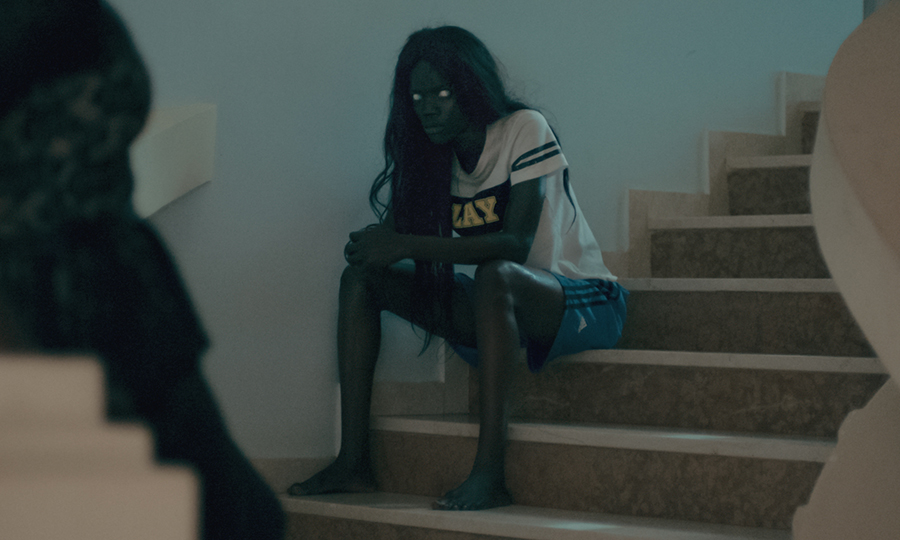
How do we know she is possessed? When we say that she is possessed, we mean that her lover or brother or friend is not present, that he is lying dead at the bottom of the sea; but that he is somehow, impossibly, against the laws of biology and chemistry and physics, here, in front of us. The task of the film is to give us this paradoxical experience: to allow us to both see him and not see him. It is paradoxical because the second the film reveals the ghost to us, he is no longer absent—he is no longer haunting. It would bring the outside of our experience inside, and thus demystify it.
The film forces us to linger with these girls. We see their uncanny eyes, watch them sit like their lovers and brothers and friends would sit, watch them laugh like their lovers and brothers and friends, watch them demand their money. We watch them walk unnaturally, like computer simulations; human beings aren’t supposed to walk that way. We see them become something new, without outwardly changing.
This is an experience the philosopher Stanley Cavell has remarked on. How, he asks, could we distinguish between an automaton—a thing that looks like a human being, but is made, not born—from a human being? He poses a series of hypothetical automata, each progressively gaining the appearance of something we might identify as “part of being human.” The automaton appears to feel pain, appears to have internal organs, appears to die, appears to be self-aware, appears to appeal to fellow human feeling; but at every step of the way, there is the demonic inventor, there to clap his hands in glee at his latest innovation. The result is a growing, disquieting distrust in one’s capacity to answer the question. When does appearance become evidence of reality? When can we say that a human being has revealed itself to us? Ultimately, Cavell argues, there is no final criterion for this question. Humanity—as a marker, a category, a prize—reveals itself to be elusive, precarious: “It may be lost or invaded … we may be, or may become, something other than we are, or take ourselves for.” Cavell names “the perception of the precariousness of human identity” simply: horror.
In one glorious sequence, Atlantics luxuriates in this uneasiness. Upon returning to the bar this community of boys and girls once called home, Ada sees her friends.
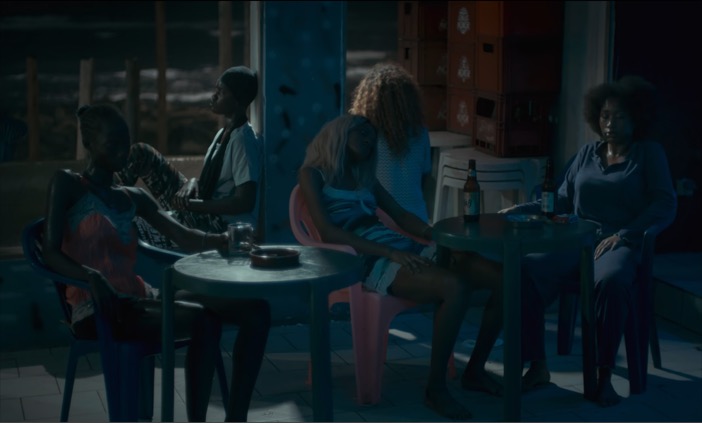
But she sees something more.
In the mirrors scattered around the bar, Ada sees boys who are not there. Her friends sit where they ought to be. What does it mean to say that the boys are not there, when they so clearly are? What does it mean to say that they are there, when they so clearly are not?
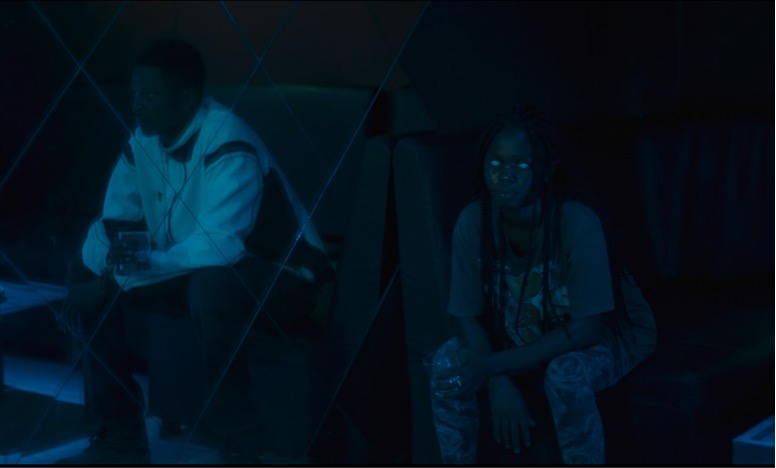
Watching this sequence evokes a sense of dizziness, as though one stands over a cliff beyond which lies something so incomprehensible we cannot even say that it is there. We must take seriously—we must feel—its genuine impossibility. A human being is both there and not there: their presence is precarious.
With this sequence, the film asks us to see the dead in the living. The mirror does not merely split the boys from the girls but forces us to accept that the boy is impossibly, exactly where the girl is. We look at her knowing that somehow she embodies, or reveals, something we cannot see. She becomes mysterious, impossible, she/he/they. Reality is infected by the unreal. Presence is inflected by absence. The flesh of the girls—gleaming like a dark tower—radiates an irredeemable pollution: blasphemy, incarnated.
Atlantics does not simply literalize a metaphor—about colonialism, or capitalism, or racism. It reveals the particular feeling, the particular way in which the world appears, that connects literal and metaphorical hauntings. That feeling is the experience of the world—the material before one’s eyes—as possessing more than is revealed. It is the experience of matter as infected by the immaterial, by vanished or impossible matter. It is an aesthetic, a sensuous particularity, a precise flavor of pristine rot. It is a way the world looks. Not just people, but things: towers and beds, chains and prison cells, the ocean.
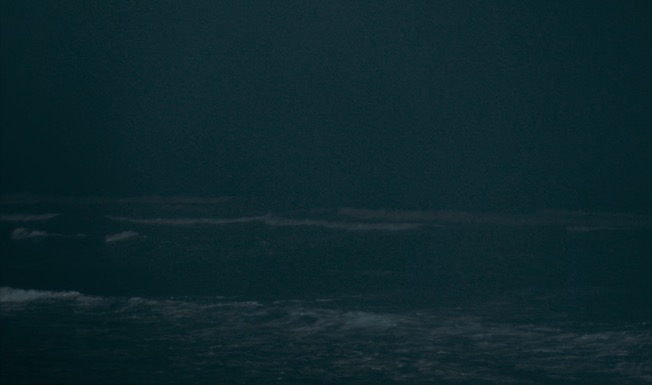
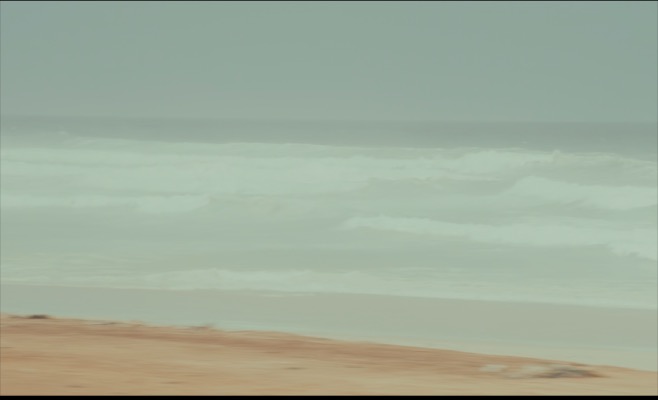
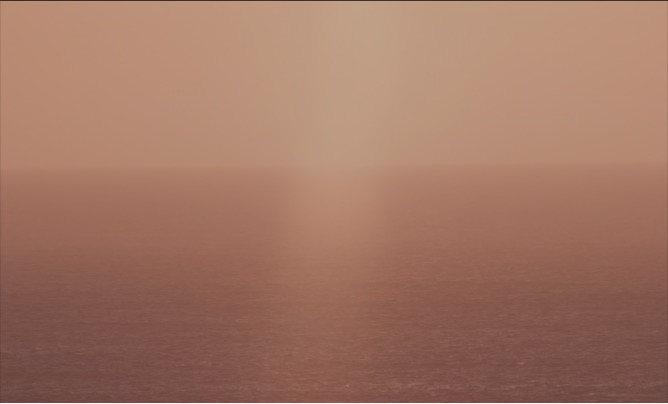
The camera lingers on these views, often without narration. There is no corpse, no walking dead, no spectral ectoplasm. There is nothing beyond these ceaseless waves. And yet, somewhere beyond them, men—boys—died. They sank below the water and drowned. They never saw Spain. They never saw France. They never saw the empire. They died in it. Thousands of migrants drown in the Atlantic every year. About 1.8 million slaves lie at the bottom of the ocean, thrown overboard after dying en route to Haiti, or New York, or London. We will never see those bodies. All we will see is a groaning mass of waves.
●
Black horror’s task is the revelation of great evil. It accomplishes that disclosure precisely by failing to do so. The world of black life is not just a world in which brutality exists. That brutality is often unseen, vanished, in structures and legal codes and countries far away, in the unknowable lands of the past and the future. In black horror, every inch and every moment of life becomes infected by that invisible wrongness. The architecture of everyday life becomes colored and textured by a psychic parasite that looms in some foreign dimension of time and space. That parasite can be named anti-blackness, but only if such naming allows us to retain that feeling of impossible presence that Lovecraft so painstakingly documents.
That feeling is what horror makes possible. Perhaps it is better to say that these films, and their supernatural, impossible hauntings, are not just literalizations but intensifiers. They make it difficult to disregard this sense of structuring mystery. Their aim is not clever observation but the generation of a particular feeling, one that spreads beyond its origins to infect an entire cinematic world. That feeling makes it possible to say, with conviction, that the world is haunted by anti-blackness. The next installment of this series will explore what comes of such an utterance: the aesthetics, and the politics, this statement opens up.
This is the second column in a four-part series by Nicholas Whittaker on black horror. Read the first here.
H.P. Lovecraft dreamt of unholy architectures. His stories abound with accounts of attic rooms with “peculiar angles”; “dimly sinister” cathedrals; “ancient tottering” cottages exuding “faint miasmal odour”; “malodorous and fear-shadowed” towns rotted with “irredeemable pollution.” These places are haunted. Too real, too present, they nonetheless somehow embody what lies “outside the boundaries of the world of space we know.” Their brute material form, their look and texture, is suffused with a fundamental wrongness. Such uncanniness is only heightened in Lovecraft’s visions of genuinely foreign and unnatural edifices: the crumbling ruins of cities that once housed monstrous, inhuman beings; monoliths paying homage to secret and unbelievable gods; metropolises in strange, forgotten lands outside our present dimensions; passageways that are simply too big buried under desert sands: the playgrounds and torture chambers of species and divinities now gone from the earth, or hiding dormant in its core, or returned to their alien worlds.
These hallucinatory imaginations reach a loving climax in At the Mountains of Madness, published months before Lovecraft’s death. The novella’s plot largely consists of Antarctic explorers stumbling across, then painstakingly exploring, a massive, empty city that once housed a grotesque prehistoric race. Lovecraft strains to convey the horror of its physical form:
It is no small feat that a moment in Atlantics, Mati Diop’s 2019 debut feature film, evokes that precise admixture of emotion. Many have attempted to adapt Lovecraftian horror to the screen, but most have failed. The grandiosity, the whiff of insanity, above all the translation of metaphysical blasphemy into “stark, objective, and ineluctable reality” escape their efforts. But not this one.
This shot emerges nearly exactly in the middle of the film, and I cannot quite capture the disquieting sense of animism, the aura of breathing, unnatural life that wreathes this dark tower. It thrusts high above the landscape of Atlantics, looking for all the world like the “blasphemous fortress” that looms over the ancient kingdom of K’naa in Lovecraft’s story “Out of the Aeons,” a “distant and geometrically abnormal outline against the sky.” At its crown sits a perverse star.
But does this temple merit such florid description? After all, it is not in K’naa, or the cobwebbed streets of Lovecraft’s Arkham, or the great mound of K’n-yan, or the faraway lands of Kadath or Lomar. It was not erected by the cult of Cthulhu, or the worshippers of Shuggoth, or the mad prophet Abdul Alhazred. Nothing so grandiose—it lies in the city of Dakar, on the westernmost point of the Old World, overlooking the Atlantic Ocean, in Senegal. And it is a luxury high-rise, overseen by a man named Mr. Ndiaye, built by the hands of Senegalese men. It is nothing more sinister than that.
The dreadful power and arrhythmic beauty of Atlantics lie in the fact that this is enough. In the shimmer of the tower’s black glass, Diop’s camera sees the radiation of an irredeemable pollution. That atmospheric smog does not choke the streets of Dakar so much as constitute them. The world of Atlantics is made of a material that unspools in disorienting bends and waves impossible to calculate. We might, if we were feeling clever, call that material “colonialism,” “anti-blackness,” “capitalism,” “patriarchy” or any number of other well-meaning, correct, but ultimately insufficient phrases. The architectural textures—the physical, tangible space—of Atlantics exceed these political categories and moral condemnations; this is what makes the film horrifying.
Here lies the first thesis of black horror: the black world is a Lovecraftian world. It is not a world that simply contains some sort of atrocity. The evil of anti-blackness is so unnatural, so monstrous, that it seems to come from outside the boundaries of the world of space we know; it goes against the sense of everyday life. And yet that outside is, impossibly and horrifically, here, all around us: engraved in the atoms and the kinetic energy of stark, objective and ineluctable reality. What Atlantics shows so brilliantly is that the presence of that outside transforms reality, rendering it precarious—and haunting.
●
The plot of Atlantics is simple. A girl, Ada, is in love with a boy, Souleiman, but is engaged to another, Omar. Omar is rich; Souleiman is a construction worker, building Mr. Ndiaye’s Tower of Babel. But Mr. Ndiaye fails to pay his workers for months, and so a cadre of them—including Souleiman—attempt to sail from Dakar to Spain. The boat sinks, and the boys drown.
And yet, they return. Each night, a group of girls—friends and lovers of the boys—are possessed by the dead. They haunt Mr. Ndiaye, threatening him with escalating retribution until he pays their loved ones the long-overdue wages. Not Ada, though: Souleiman does not enter her, but rather the policeman questioning her for her involvement in these acts of aggression. That is because, as she eventually learns, he only wishes one thing: to see her again, to give her the goodbye he was too afraid to offer before. They share one night together, Ada and the policeman and Souleiman. The boy leaves.
Dakar is the westernmost point of the continuous landmass now conceptually split into Africa, Europe and Asia. Just south of its tip is the small island of Gorée. Gorée was one of the first territories in what is now known as Senegal to be colonized by France, who would later claim the vast majority not only of Senegal but of northwestern Africa. This eastward expansion would not begin in earnest until the mid-nineteenth century. Until then, Gorée served purpose: West Africans would bring peanuts, gum arabic, ivory and, most of all, slaves to Dakar, and then Gorée, to sell to European traders. This island—the Door of No Return, now a macabre tourist destination—helped pump the blood of the Atlantic slave trade. In a grim irony, the abolition of slavery in the French colonies in 1848 opened the door to formal colonization in West Africa. Senegalese slave owners and traders were stripped of their main source of income and labor force—a blow to the indigenous economy that provided a foothold for the French to expand into the mainland. Of course, this did not change much in one important sense. As before, the economic security of Senegal remained across the Atlantic, in the French companies distributing Senegalese peanuts, the country’s main cash crop. Across these centuries, Senegal was haunted by lands far beyond it, perforated with circulatory systems latched to shadowy masses imperceptible by the human eye. This is colonization: possession.
Even after independence was declared in 1960, there was no final severance from the biomass named France. The Senegalese economy remained heavily entangled with the metropole. Now, however, the burgeoning Senegalese bourgeois would receive a larger slice of the pie. This use of colonial continuity for elite gain would only grow with Senegalese liberalization at the turn of the twentieth century. As of 2021, Senegal is ranked 170th in the Human Development Index, even though the nation has a relatively strong GDP among African countries and an unemployment rate of under 4 percent. The disjunction is the result of vast stratification: while the elites of Senegal are made discomfortingly wealthy by foreign investment and trade, nearly half the country lives below the poverty line.
Atlantics is an attempt to make a movie that distills, in Diop’s words, the “very ghostly atmosphere reign[ing] in Dakar.” The film is clearly about colonialism and anti-blackness and slavery. Mr. Ndiaye transforms his Senegalese workers into literal slaves by refusing to pay them; their flight to Spain, a flight that could only end in either death or underpaid migrant labor, is the ferrying of slaves from one corner of the empire to another. The brutality of this cycling of human equipment haunts Dakar, hanging over its inhabitants even when it occurs far out at sea. And over them all hovers the tower: a grotesque obelisk, a summoning rod, a psychic tuning fork, exchanging human lives for foreign investments in a ghostly economy.
Imagine colonial extraction as a chthonic ritual, overseen by indigenous high priests. These mediums, alternating schizophrenically between French and Wolof, midwife a psychic infestation of the material world by a formless, nameless thing: no mere country, no mere emperor, but an overwhelming beast of structures, relations, dynamics, ways of being and thinking and doing, an entire shadowy world called empire. Such a way of talking fleshes out the metaphorical sense—if indeed that sense is merely metaphorical—in which France, colonialism, slavery haunt Senegal. To be haunted is to be privy to, to be formed by, to be terribly indebted to something utterly beyond you, something outside the boundaries of the space you know. This outside has formed Senegal, and dismembered it, facilitated by its wealthiest inhabitants.
The film’s possession narrative, then, simply makes this metaphorical way of talking literal: Dakar is literally haunted by its dead. A second thesis of black horror: the films show us what it would look like if metaphorical descriptions of the reality of anti-blackness were made literal. In this film, that reality is European colonialism, the slave trade and economic disenfranchisement. But in others, we are shown the reality of migrancy (His House), American chattel slavery (Beloved, Antebellum), black fetishism (Get Out), cultural displacement (Ganja and Hess) and so on. These realities are united, of course, by the trauma, the black suffering, that lies at their core. One might say that living in migrant housing feels like living in a haunted house; as IndieWire puts it, His House “sees the immigrant experience as a horror movie.” One might say that black fetishization feels like the desire to be consumed; as the New York Times describes Get Out, “one person’s fiction, after all, is another’s true-life horror story.” One might say slavery felt like being transported into hell; as the Washington Post describes Beloved, the film’s ghost is a “metaphor for the vestiges of a horrific past.” Or one might say that living in Senegal feels like being haunted by a monstrous parasite that absorbs money and lives and land, and by the ghosts of those consumed by it.
But why bother with these particular metaphors? What do they offer us, such that we now dedicate an entire genre to them? Why horror?
●
In order to answer that question, let us first ask how: How does Atlantics literalize horrific metaphor? How does it depict haunting? That question goes oddly unexplored in discussions of the “reality” that black horror films show to us. Perhaps that is because posing it reveals a problem. How could one capture, with a film camera, being haunted, if being haunted is the experience of what is not present? Film cameras, after all, show us something. They make something present—a river rushing, a twisted tree, that look in someone’s eye. Whatever it is, we get to see it: movies reveal the world to us.
Clever movies make clever use of this. A film may reveal a schizophrenic’s delusions as though they were “really happening.” Another might, in telling the story of two lovers separated by an ocean, transpose the two over each other through fuzzy dissolves or jarring split screens. A third might use smoke and mirrors and CGI to trick us into seeing something that isn’t there. In these ways, films allow our experience of the world to grow, to swell beyond the confines of our typical experience. Inner worlds play out in sound and color; dreams become real; the border between reality and fantasy crumbles.
But within this power lies the problem. For the metaphor of haunting seeks to capture some sense in which something is both present and not present, seen and not seen. Trying to imagine the experience of something “outside the boundaries of the world of space we know,” we run into a crisis that has haunted philosophy since at least Hume, and perhaps a great deal longer: How can we know what we do not know? How can we experience that which lies beyond experience? How can we circumnavigate the limits of thought? The horror Lovecraft describes is the terror that accompanies the contemplation of this crisis. To contemplate the possibility of a world beyond the limits of one’s contemplation, to grapple with one’s own fundamental finitude in a reality that is so inhuman as to be indescribable in our terms and yet is parasitic, birthing us and threatening us again and again: such wonders are inherently destabilizing. They haunt us.
Very well: But how do we make movies about this? In Atlantics, a girl is possessed. She/he/they waits for Mr. Ndiaye in his home, with her/his/their comrades. They threaten him, and then they leave. They’ll return.
How do we know she is possessed? When we say that she is possessed, we mean that her lover or brother or friend is not present, that he is lying dead at the bottom of the sea; but that he is somehow, impossibly, against the laws of biology and chemistry and physics, here, in front of us. The task of the film is to give us this paradoxical experience: to allow us to both see him and not see him. It is paradoxical because the second the film reveals the ghost to us, he is no longer absent—he is no longer haunting. It would bring the outside of our experience inside, and thus demystify it.
The film forces us to linger with these girls. We see their uncanny eyes, watch them sit like their lovers and brothers and friends would sit, watch them laugh like their lovers and brothers and friends, watch them demand their money. We watch them walk unnaturally, like computer simulations; human beings aren’t supposed to walk that way. We see them become something new, without outwardly changing.
This is an experience the philosopher Stanley Cavell has remarked on. How, he asks, could we distinguish between an automaton—a thing that looks like a human being, but is made, not born—from a human being? He poses a series of hypothetical automata, each progressively gaining the appearance of something we might identify as “part of being human.” The automaton appears to feel pain, appears to have internal organs, appears to die, appears to be self-aware, appears to appeal to fellow human feeling; but at every step of the way, there is the demonic inventor, there to clap his hands in glee at his latest innovation. The result is a growing, disquieting distrust in one’s capacity to answer the question. When does appearance become evidence of reality? When can we say that a human being has revealed itself to us? Ultimately, Cavell argues, there is no final criterion for this question. Humanity—as a marker, a category, a prize—reveals itself to be elusive, precarious: “It may be lost or invaded … we may be, or may become, something other than we are, or take ourselves for.” Cavell names “the perception of the precariousness of human identity” simply: horror.
In one glorious sequence, Atlantics luxuriates in this uneasiness. Upon returning to the bar this community of boys and girls once called home, Ada sees her friends.
But she sees something more.
In the mirrors scattered around the bar, Ada sees boys who are not there. Her friends sit where they ought to be. What does it mean to say that the boys are not there, when they so clearly are? What does it mean to say that they are there, when they so clearly are not?
Watching this sequence evokes a sense of dizziness, as though one stands over a cliff beyond which lies something so incomprehensible we cannot even say that it is there. We must take seriously—we must feel—its genuine impossibility. A human being is both there and not there: their presence is precarious.
With this sequence, the film asks us to see the dead in the living. The mirror does not merely split the boys from the girls but forces us to accept that the boy is impossibly, exactly where the girl is. We look at her knowing that somehow she embodies, or reveals, something we cannot see. She becomes mysterious, impossible, she/he/they. Reality is infected by the unreal. Presence is inflected by absence. The flesh of the girls—gleaming like a dark tower—radiates an irredeemable pollution: blasphemy, incarnated.
Atlantics does not simply literalize a metaphor—about colonialism, or capitalism, or racism. It reveals the particular feeling, the particular way in which the world appears, that connects literal and metaphorical hauntings. That feeling is the experience of the world—the material before one’s eyes—as possessing more than is revealed. It is the experience of matter as infected by the immaterial, by vanished or impossible matter. It is an aesthetic, a sensuous particularity, a precise flavor of pristine rot. It is a way the world looks. Not just people, but things: towers and beds, chains and prison cells, the ocean.
The camera lingers on these views, often without narration. There is no corpse, no walking dead, no spectral ectoplasm. There is nothing beyond these ceaseless waves. And yet, somewhere beyond them, men—boys—died. They sank below the water and drowned. They never saw Spain. They never saw France. They never saw the empire. They died in it. Thousands of migrants drown in the Atlantic every year. About 1.8 million slaves lie at the bottom of the ocean, thrown overboard after dying en route to Haiti, or New York, or London. We will never see those bodies. All we will see is a groaning mass of waves.
●
Black horror’s task is the revelation of great evil. It accomplishes that disclosure precisely by failing to do so. The world of black life is not just a world in which brutality exists. That brutality is often unseen, vanished, in structures and legal codes and countries far away, in the unknowable lands of the past and the future. In black horror, every inch and every moment of life becomes infected by that invisible wrongness. The architecture of everyday life becomes colored and textured by a psychic parasite that looms in some foreign dimension of time and space. That parasite can be named anti-blackness, but only if such naming allows us to retain that feeling of impossible presence that Lovecraft so painstakingly documents.
That feeling is what horror makes possible. Perhaps it is better to say that these films, and their supernatural, impossible hauntings, are not just literalizations but intensifiers. They make it difficult to disregard this sense of structuring mystery. Their aim is not clever observation but the generation of a particular feeling, one that spreads beyond its origins to infect an entire cinematic world. That feeling makes it possible to say, with conviction, that the world is haunted by anti-blackness. The next installment of this series will explore what comes of such an utterance: the aesthetics, and the politics, this statement opens up.
If you liked this essay, you’ll love reading The Point in print.